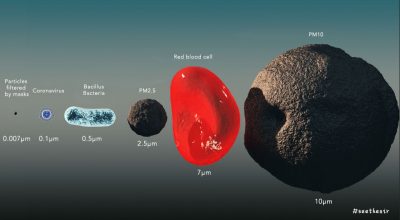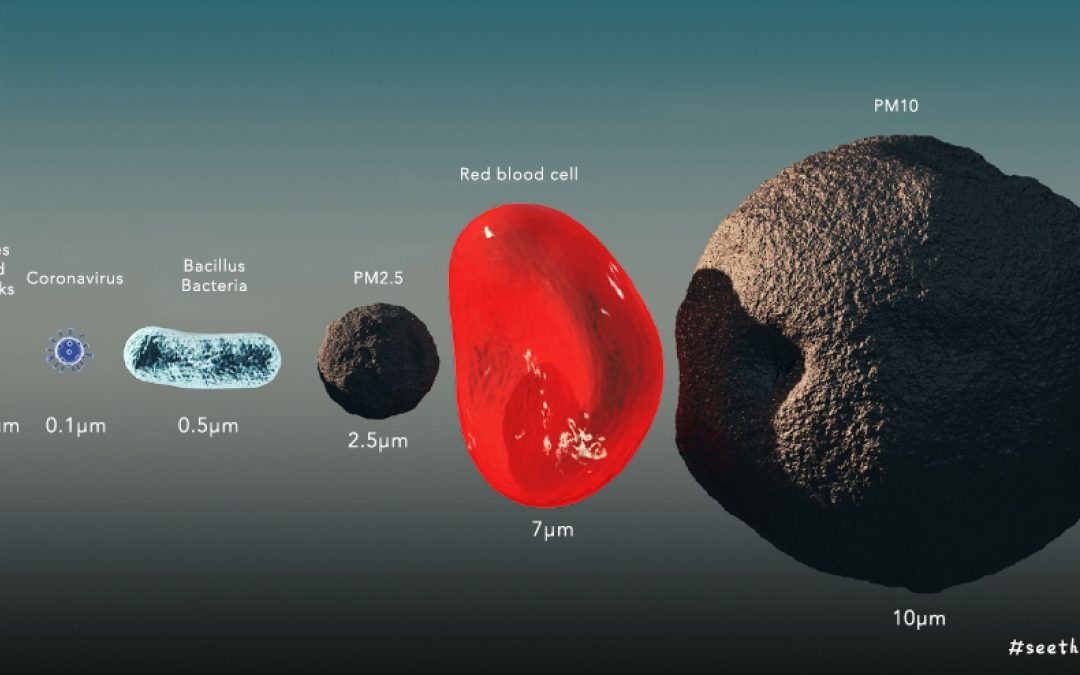What are viruses?
Viruses are a specific type of microorganism. We are routinely exposed to microorganisms and most of them are harmless to us because they are either harmless to us or our immune system protects us from them.
Microorganisms which cause infections are called “pathogens”.
Viruses are the smallest form of living organisms. They are 1/100th the size of bacteria. They require a host in which to grow, and they highjack living cells in order to replicate.

Figure 1. Sizes of Viruses, Bacteria and Particulate
What is COVID-19?
SARs-CoV-2, the virus causing the disease COVID-19 is a type of coronavirus. There are thousands of different coronaviruses and only seven are known to infect humans, including the common cold and COVID-19.
The origin of this novel virus is thought to be animal to human transmission at a wholesale food market in Wuhan. Environmental samples from the market tested positive for SAR-CoV-2.
Normally, with any sort of an infectious agent we would determine the infectious dose and do industrial hygiene assessments (for which methods are available if CIHC were requested to do so) to determine where concentrations are in relation to that infectious dose. Unfortunately, there is no solid data on this at this time, so any testing would be done simply to determine the presence or absence of the virus and recommendations would be made to try to eliminate its presence.
6%-41% of individuals infected with COVID-19 are asymptomatic. For the remainder of individuals infected they may have respiratory symptoms, gastrointestinal symptoms, long-term consequences of infection and in some case, death.
How is SARS-CoV-2 Transmitted?
Routes of transmission include droplet, airborne, surfaces, fecal-oral, bloodborne, or animal to human.
SARS-CoV-2 survives in indoor air 2-16 hours and in outdoor air it survives less than an hour. Its survival rate on surfaces is variable: up to 72 hours on plastic and stainless steel, up to 24 hours on cardboard and less than four hours on copper. Higher humidity, temperature and solar radiation reduces its ability to infect.
What Are the Controls Used to Reduce the Spread of COVID-19?
Controls against COVID-19 infections include:
- limiting human-to-human contact,
- wearing face-coverings,
- reduced face touching,
- the use of disinfectants,
- hand hygiene, and
- vaccinations..
Studies show that airborne particle generation depends upon volume of air, so many restrictions center around areas where singing and speaking are prevalent, such as:
- schools,
- religious establishments,
- restaurants, and
- bars.
While more relaxed measures are taken in areas where there is typically no singing and less talking such as retail stores and grocery stores.
Interestingly, one of the methods of reduction of airborne particle generation for restaurants and bars is to lower the sound intensity of music so that people within the establishment are not speaking as loudly, resulting in people expelling a lower volume of air.
What do we know about COVID-19 reinfections?
Reinfections are known to occur and they sometimes result in more severe symptoms. Reinfection is an aspect of the disease which is poorly understood.
Resources
ISRP 2020: The Role of Respiratory Protection in Response to Coronavirus: European Response to SARS-Cov2 (COVID-19) Outbreak https://youtu.be/lyJGgZYCTAI
https://abcdust.net/how-large-is-a-corona-virus-virion-compared-to-the-mp10-2-5/

